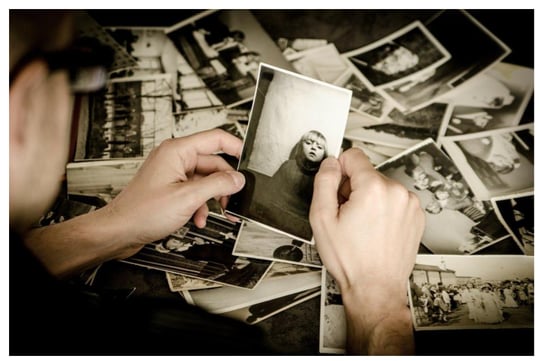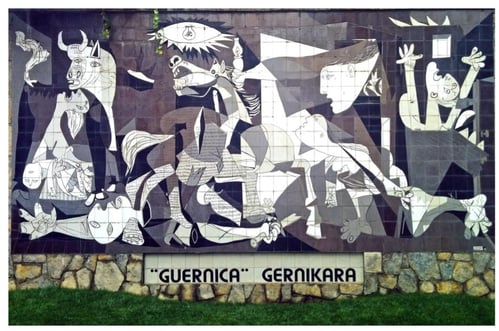
When creating art, there are several elements to consider—line, color, scale, subject matter, etc. But what about art composition?
It seems simple enough, right? Create a piece with compelling enough imagery, and then the rest is cake. Right??
Yet if you study famous acrylic paintings, you’ll notice that great composition is at the heart of their visual impact. Where you place your subjects in a piece of artwork is called “composition.”
Many steps go into creating the perfect composition in art, such as scale, imagery, cropping, considering the rule of thirds and golden ratio, and of course, the inner self.
Photo caption: Artists can learn a lot about art composition by studying masterpieces, like the Mona Lisa. Image by Free-Photos from Pixabay.
🖌️ Want to master composition and create art that captivates?
Join hundreds of artists transforming their creative process through our Mastery Program. From design principles to professional-level critique, this immersive experience will sharpen your skills and elevate your art.
👉 [Apply for the Mastery Program Today]
1 - Choose the Size You Want
The first step to creating expert-level art compositions would be choosing the right size canvas. Different dimensions and sizes can really affect a composition's layout.
If you are doing a tall and skinny canvas with a 1:3 or similar ratio, you will want to be looking for imagery that suits this size. Otherwise, some of the design elements may look wonky in the finished piece.
Painting a blue whale swimming forward or a woman lying down horizontally may not necessarily suit these dimensions. The imagery you choose should fit comfortably in the perimeter of the canvas, and make sense according to the idea you have in mind.

2 - Choosing Sources for Your Art Compositions
In your composition, you want things to feel comfortable. You don't want images that sit too close to the edges. It's important that the positive space is balanced out by the negative space. It's also important to choose (or create) an image that highlights one focal point above all others.
It's additionally important to avoid tangent edges and include a bit of overlap. You want to avoid the feeling of being trapped, stuck, or the feeling of falling.
Photo caption: Finding the right visual references for your paintings is critical if you want good art compositions. Image by Michal Jarmoluk from Pixabay.
For example, if you have a figure running to the right, you will want to leave room in front of them to run. Placing a subject in motion facing the edge of the canvas with no room to move leaves the viewer feeling trapped.
When creating sources and choosing your imagery, it will save time and energy to plot out your images on the correct canvas ratio. You also want to be sure your images are not awkwardly chopped or in strange positions.
With animals, you should generally avoid images with exaggerated or skewed perspectives and foreshortening. You want to find animals with all legs/limbs showing, and as much detail as possible. This is a rule in source-making in general!
Don’t get seduced by beautiful photography (although you can learn a lot about composition by looking at a good photograph 😄)
3 - Taking or Creating Your Own Source Images
Finding images to use for a specific idea for a painting can be a vigorous, time-consuming task. Many artists opt for taking their own source photos for this exact reason! Taking photos for sources for a painting is very different from taking a beautiful, dramatic photo.
Think about the story it creates, and how it will translate as a painterly piece of art. Consider your own style as well! If you paint hyper-realism, you will want every single element of your source to be exactly what you want in the painting, or at least be aware of it.
If you are a more expressive artist, the details in the background may be less important, but you will still want to make sure your subject matter has the right lighting and contrast that you want and that things are in focus.
When taking your own photos, lighting is absolutely key. You want your subjects to be illuminated with core and cast shadows to create a sense of drama and dimension. Having a washed-out subject will leave you with very little information to paint from, thus causing frustration. Let’s avoid that!
Set up your lighting on the left or right side of your subjects, thus allowing the subject to have various cores and cast shadows. You also will want the main imagery to be in perfect focus. There is nothing worse than trying to paint from a blurry, unclear source. Take your time with this step, and remember to take LOTS of photos.
There will be many unusable ones, but the perfect source will be in there somewhere! If you are taking photos outside, keep an eye on where shadows are being cast.
Avoid unwanted shadows blocking details, and creating strange shapes or awkward and unflattering lines on your subjects. This principle also includes being aware of the horizon line and the implied lines that are sometimes created by the visual elements in our photo references.
Granted, some brilliant art compositions can be created by playing around with these features. However, you must use design elements, like implied lines, intentionally. Pablo Picasso's piece "Guernica" uses actual and implied lines brilliantly to move the eye around the painting.
Artists have artistic license when painting, and can easily paint out things that they don’t want, but it makes it much easier if you are starting off with a good solid source photo.

3 - Create Your Own Crop in Your Art Compositions
You will inevitably end up with a lot of unusable photos in your photoshoots for source material. However, there may be a lot of photos that, with the right crop, might work just fine.
In addition to combining photos, you can also take existing photos and crop them to perfectly follow the rule of thirds, making them great source candidates. When you crop your photos, be sure you are not cutting things awkwardly.
Photo caption: “Guernica” by Pablo Picasso. Photo by Almudena Sanz from Pixabay.
What that refers to is, say, the arm of a woman, or cropping her elbow off or even the top of her head. You will want to look for a lot of overlap in your piece. You’ll also want to avoid awkward cropping.
Finally, combining photos is also a great way to go if you have multiple photo shoots you want to combine ideas from. Planning your art composition is very easy. You can do it on your phone or laptop via editing apps, or even sketch it out on a piece of paper.
4 - Rule of Thirds
The rule of thirds is incredibly important.
To follow the rule of thirds, look at your canvas and imagine it split into three even pieces horizontally and vertically. Where those lines intersect is where you want your focal point to hit. Four points are the perfect spots for a focal point.
The worst spot you can put your focal point is in the center, which many artists unknowingly do. It may seem logical; you want the viewer to look there, and the middle is such an obvious place!
However, great art composition allows the viewer’s eye to travel around the piece and then return back to the original point. With a centralized focal point, the viewer’s eye tends to get stuck and will move on quickly from the piece.
5 - Golden Rectangle in Art Compositions
The golden rectangle in art compositions (and life) incorporates the measurements of the Fibonacci sequence to create symmetry in the composition. The most beautiful flower bulb, the most intricate snail shell, and the most breathtaking work of art all employ this compositional structure.
For us as artists, the closer our work gets to recreating this natural compositional element, the more beautiful our work becomes. Drawing from life teaches us about the golden ratio because we observe how the proportions of our bodies, of plants, of everything follow the sequence of the ratio.
If we draw and paint enough from life, we will get an internal sense of the ratio and how to incorporate it into our work. As humans, we are naturally drawn to imagery that is in this divine rectangle. It is pleasing to us, as it satisfies a primal desire for perfection, beauty, and balance.
6 - Art Composition and the Inner Self
As many artists know, the art you create is very telling of what is going on inside you. If there is chaos inside you, it appears in your composition. Artists who had a very chaotic childhood even tend to be drawn to more structured and linear compositions.
Likewise, artists whose childhoods were strict and reformed prefer the chaos and freedom in composition. This dynamic is fascinating. Take a look at any of your favorite artists, what do you see? Is their composition filled with organic shapes, lots of little objects overlapping, straight lines everywhere, precision, or a little bit of everything?
Next time you are admiring a work of art, consider the composition. It will surprise you to know that what you are drawn to says a lot about you, as well.
Final Thoughts on Creating Expert Art Compositions
There’s a lot more to art composition than simply keeping a subject within the lines. Excellent composition in art sets the stage for the story you will tell with your paintbrush! To quickly overview:
- Pick your canvas size first
- Find compelling imagery
- Find overlap, avoid tangent edges and award crops
- Remember the rule of thirds
- Divine proportion is within us all
If you are unsure about your newest composition, we encourage you to phone a friend! Ask the people around you who have fresh eyes and no attachment to the idea if anything feels uncomfortable.
Listen to what they have to say, and consider any adjustments they suggest. Once you feel comfortable with your composition, it’s time to take it to the canvas.
Or if you’d like more in-depth instructions for creating art compositions, consider applying for our Mastery Program.

